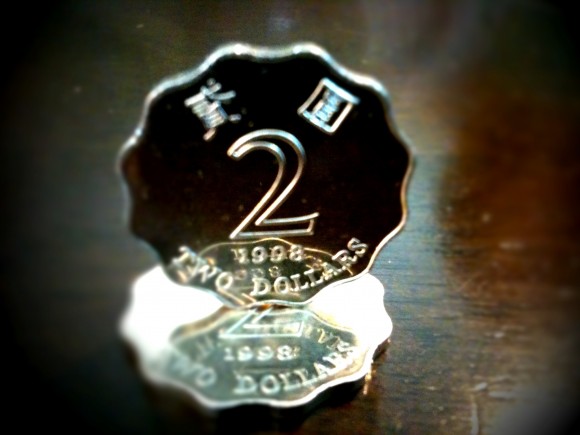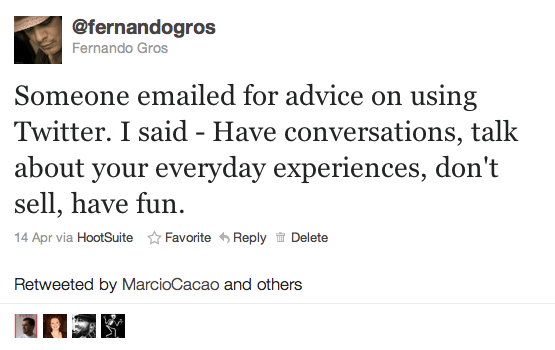My Approach To Twitter
Over the past few weeks I’ve had a few people ask me about my approach to Twitter. I’m loathe to write anything too concrete on the subject because a) I’m neither an expert on the subject, b) I’m not really “successful” on Twitter. Moreover, there is a whole body of “how to use Twitter” literature […]
Over the past few weeks I’ve had a few people ask me about my approach to Twitter. I’m loathe to write anything too concrete on the subject because a) I’m neither an expert on the subject, b) I’m not really “successful” on Twitter. Moreover, there is a whole body of “how to use Twitter” literature out there – most of which is vile and repulsive – so who needs my two Hong Kong dollars on the subject?
Except that people keep asking. A couple of weeks ago I summed my thoughts on how to use Twitter – in a tweet,
In a way it’s that simple for me. For a more thought out answer on how to approach Twitter, check out this great interview with David du Chemin – Stop Selling, Start Connecting (incidentally, David had a bad fall while working Italy, updates here and here).
“You would never walk into a room and, without introducing yourself, assume that everyone wants to hear about your latest greatest thing would you? Most of us will spend time actually listening to people, finding out who they are, and gaining their trust before we try to sell them our AmWay products. Just because it’s technology, that doesn’t give you carte blanche to abuse people with your sales pitches.”
“You’ve got to find your own voice. If that is crass and rude and foul-mouthed, then be that person. Because you want your audience to be authentic, one that comes to you because there’s a genuine connection. I don’t really believe in this distinction between work and play. What’s amazing about that is, if you’re not seeing the division between work and play, you’re also not dividing people into “friends” or “clients.” They’re just people.”
That kind of clarity lets us bypass all the “be a brand,” or “be an influencer,” rubbish that is out there. After that, there are a few practical questions to address.
1. Platform – Like most people I started out using Twitter’s own web-based interface. I still use it sometimes to check out who is following me and look at lists. But, once you start following more than a couple of hundred people, it becomes impractical.
There are plenty of alternatives, but the ones that install onto your computer typically require Adobe Air. Since I’m loathe to install anything that “runs in the background,” I opt to use HootSuite inside a browser (Safari). With HootSuite I can see people’s updates in columns, organised by lists. Twitter lists allow you to group people you want to follow according to categories of your making (e.g., photographers, writers, or people in a specific location).
I also use the HootSuite App on my iPhone, but I’m not too precious about that. The main thing I look for in a mobile Twitter app is the ability to post quick photos and to reply to other users. Over the past few weeks the HootSuite app has been unstable and I’m probably going to check out some other apps.
2. Writing – I have a few personal rules about writing for Twitter. I don’t tweet about other people without their consent. I don’t post links to articles unless I’ve actually read and found them really interesting. I don’t repeatedly send links to the same content (I’ll usually post links to my own blogposts and photos twice over a 36 hour period, most other articles only once).
And, I schedule most of “tweets.” Yes, that’s right. When you see a link to my photo of the day going out in the morning, Hong Kong time, I’m not actually hitting send. I might be off taking photos, or practicing guitar or reading a book. I do this with the schedule function in HootSuite and it’s an essential part of balancing Twitter with a productive life (well, for me). I’ll expand on that in the Unplugging section below.
Typically I read emails, blogs and news once or twice a day. Often in the morning, after breakfast, around 7-7.30am, then either in the late afternoon or early evening. I then take anything that might be interesting to my Twitter followers and schedule Tweets (or updates, as I like to think of them) for the next 24-48 hours.
3. Replying – In general life I believe it’s polite to reply to people who say hello and my approach on Twitter is the same. I try to reply to most comments people address to me within a day. Typically I do that in the same blocks of time that I’m scheduling new updates.
I will use natural breaks in the day like travelling in a cab, waiting for a train, or riding an elevator to reply to people. However, I’m tending to do that less and less these days.
4. Direct Messages – Twitter has a direct message system which I try very hard not to use. It’s messy and I’d rather direct that kind of communication to email.
5. Following – For me Twitter is all about finding new and interesting people. So, I’m constantly on the lookout for people to follow.
What do I look for in new followers? For me, the most interesting people on Twitter are the people who are doing interesting stuff in the real world, having fun with that and talking about it in a human way.
6. Unfollowing – To balance the growth of new followers, I’m also occasionally unfollowing people who have stopped using the service or become uninteresting (to me). The best services for unfollowing people keep changing as Twitter makes technical adjustments to its service, so whenever I decide to “tend the garden” I’ll google for recent reviews of unfollow sites.
7. Unplugging – At the heart of my approach to Twitter is maintaining plenty of time away from the service. Social media can breed an always plugged in, always available mentality. That can be a lot of fun and great for certain kinds of jobs. But, I think for musicians and other people in “creative” fields, it can be poison.
I’m disappointed if I can’t point to at least two four hour stretches in the day when I haven’t checked my Twitter stream and I’d like to increase that to three such stretches. It’s not a puritanical thing – it’s just about creating the blocks of time required to complete tasks and stay focussed.
I can’t switch gears and go from replying to comments on Twitter, or reading email for that matter and dive straight back into guitar practice or composing. In fact, it often takes fifteen to twenty minutes to really switch mental gears in a deep way. That means six to eight breaks for social media in a day will pretty much shred my productivity to pieces.
So I make time for Twitter, but not too much time for it. I guess my motto might be, be online with intent, so you can be offline and interesting.






